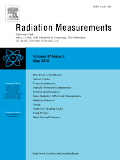
RADIATION MEASUREMENTS
Scope & Guideline
Advancing the Frontiers of Radiation Science.
Introduction
Aims and Scopes
- Radiation Dosimetry Techniques:
The journal covers various dosimetry methods, including thermoluminescence (TL), optically stimulated luminescence (OSL), and radiophotoluminescence (RPL), emphasizing their applications in medical, environmental, and occupational settings. - Advancements in Detector Technologies:
Research on novel detector designs, including scintillators, semiconductor detectors, and fiber-optic systems, is a primary focus, highlighting innovations that improve the sensitivity and accuracy of radiation measurements. - Computational Methods in Radiation Measurement:
The use of computational techniques, such as Monte Carlo simulations and machine learning algorithms, to model and analyze radiation interactions and dose assessments forms a significant part of the journal's contributions. - Environmental and Occupational Radiation Monitoring:
The journal emphasizes studies on environmental radiation levels and occupational exposure assessments, presenting methodologies for monitoring and mitigating radiation risks in various settings. - Interlaboratory Comparisons and Calibration:
A consistent focus on quality assurance through interlaboratory comparisons and calibration of dosimetry systems ensures that measurements are reliable and standardized across different research and medical institutions.
Trending and Emerging
- Machine Learning Applications:
There is a growing trend in utilizing machine learning techniques for data analysis in radiation measurements, enhancing the accuracy of dose assessments and improving signal processing in dosimetry. - 3D Printing and Novel Material Development:
The rise of 3D printing technologies has led to innovative developments in dosimeter design, allowing for customized solutions that cater to specific measurement needs and improve the functionality of radiation detectors. - Real-Time and Remote Dosimetry:
Research focusing on real-time monitoring and remote dosimetry methods is gaining traction, driven by the need for immediate feedback in clinical and emergency situations. - Personalized Dosimetry:
Emerging studies aim to develop personalized dosimetry solutions that account for individual exposure scenarios, particularly in medical applications, reflecting a shift towards patient-specific radiation safety. - Environmental and Emergency Response Monitoring:
Increasing attention is being directed towards the development of rapid response systems for environmental radiation monitoring, particularly in the context of nuclear accidents and public health safety.
Declining or Waning
- Traditional Radiation Detection Methods:
Research on older detection technologies, such as film badges and some conventional scintillators, has decreased as focus shifts towards advanced materials and techniques that offer improved performance. - Basic Radiation Physics Studies:
Papers primarily focused on fundamental radiation physics concepts without direct applications in dosimetry or measurement technology have become less common, possibly due to a greater emphasis on applied research. - Historical Dosimetry Techniques:
The exploration of historical dosimetry methods, such as older TL and OSL materials, has waned as newer, more efficient materials and methodologies take precedence in current research.
Similar Journals
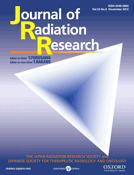
JOURNAL OF RADIATION RESEARCH
Bridging disciplines in the ever-evolving field of radiation research.JOURNAL OF RADIATION RESEARCH, published by Oxford University Press, is a prominent peer-reviewed journal focusing on the diverse fields of radiation science, including health, toxicology, and radiology. Since its inception in 1960, this open-access journal has provided a critical platform for the dissemination of high-quality research, making it accessible to a global audience of researchers, professionals, and students. With a consistent track record, the journal holds an impressive impact factor and is categorized in Q2 of Radiation studies and Q3 in Health and Toxicology as per the 2023 rankings, reflecting its influential role in shaping contemporary discourse in the field. The journal also boasts notable rankings within Scopus, further underscoring its importance in advancing knowledge and innovations related to radiation. Spanning from 1960 to 2024, the JOURNAL OF RADIATION RESEARCH remains at the forefront of scientific exploration and is essential reading for anyone committed to advancing the understanding of radiation and its effects.
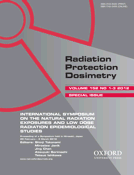
RADIATION PROTECTION DOSIMETRY
Pioneering research for a safer tomorrow in radiation protection.RADIATION PROTECTION DOSIMETRY is a vital academic journal dedicated to the field of radiation protection, published by Oxford University Press. With an ISSN of 0144-8420 and an E-ISSN of 1742-3406, this journal serves as a platform for groundbreaking research and developments in dosimetry, health physics, and radiation safety spanning over four decades since its inception in 1981. Recognized with a Q3 ranking in multiple categories including Medicine (miscellaneous) and Public Health, this journal plays a key role in disseminating important findings that inform policy, enhance practice, and promote the protection of both individuals and the environment from radiation hazards. While currently not available as Open Access, the journal's curated content is essential for researchers, professionals, and students dedicated to advancing knowledge in radiation protection and related areas. Interested readers will find the latest research trends, case studies, and reviews invaluable for their work and studies within this multidisciplinary domain.
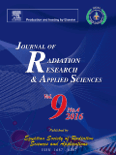
Journal of Radiation Research and Applied Sciences
Pioneering research that bridges theory and practice in radiation science.Journal of Radiation Research and Applied Sciences, published by ELSEVIER, is a premier open-access journal since 2013, dedicated to advancing the understanding and application of radiation research in various fields. With an ISSN of 1687-8507, this journal serves as a vital resource for researchers, professionals, and students engaged in the study of the physical and biological effects of radiation, radiation physics, and its applications in medicine and industry. Its rigorous peer-review process ensures the dissemination of high-quality research that meets the growing demands for innovative solutions in radiation science. By offering comprehensive access options, the journal promotes an inclusive approach to sharing knowledge with the global community. The Journal of Radiation Research and Applied Sciences stands out as a key platform for scholarly communication, fostering advancements that impact both theory and practice in the rapidly evolving landscape of radiation research.

Journal of X-Ray Science and Technology
Charting New Frontiers in X-Ray ApplicationsThe Journal of X-Ray Science and Technology, published by IOS PRESS, serves as a premier platform for researchers and professionals dedicated to advancements in the fields related to X-ray science, imaging techniques, and instrumentation. With an ISSN of 0895-3996 and an E-ISSN of 1095-9114, this journal has established itself as a vital resource since its inception in 1989. The journal has transitioned through multiple publishing phases, currently converging its years of publication from 2001 to 2024, thereby enriching the scientific community’s understanding across various categories, notably in the second quartile (Q2) of Condensed Matter Physics, Electrical and Electronic Engineering, Instrumentation, Radiation, and Radiology, Nuclear Medicine and Imaging as of 2023.
In addition to its commendable Scopus rankings—which highlight its relevance and impact within the medical and physical sciences—the journal emphasizes the dissemination of impactful research, innovative techniques, and collaborative efforts within the X-ray scientific community. Despite being a subscription-based journal, its contributions are crucial for those aiming to stay at the forefront of research and technological development in these rapidly evolving fields.
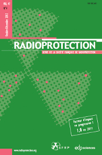
RADIOPROTECTION
Pioneering research for a safer, sustainable future.RADIOPROTECTION, published by EDP SCIENCES S A, stands as a pivotal journal in the multidisciplinary fields of Nuclear Energy, Public Health, and Environmental Safety. With an ISSN of 0033-8451 and an E-ISSN of 1769-700X, this journal delves into the crucial aspects of radiation protection and its interactions with health and environment, providing a platform for researchers and professionals to disseminate their findings and insights. Despite being classified in the Q4 quartile for Health, Toxicology and Mutagenesis in 2023, its Q3 status in prestigious categories such as Nuclear Energy and Engineering, and Public Health, underscores its relevance in contemporary academic discourse. The journal continues to expand its cachet with converged years of publication from 1977 to 1981 and 1988 to 2024, ensuring a rich history of scholarly contributions. Access options for interested readers include traditional subscriptions, allowing for comprehensive engagement with a broad range of topics surrounding safety, sustainability, and risk management. Whether you are a researcher, professional, or student, RADIOPROTECTION serves as an essential resource for expanding understanding and fostering innovation within its field.
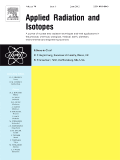
Applied Radiation and Isotopes
Pioneering Insights in Radiation ApplicationsApplied Radiation and Isotopes is a premier journal dedicated to the dissemination of high-quality research in the fields of radiation and isotopes, published by PERGAMON-ELSEVIER SCIENCE LTD. With a commendable impact factor reflecting its respected standing, this journal ranks in the Q3 category within Radiation according to the 2023 evaluation, emphasizing its relevance in the scientific community. Operating out of the United Kingdom, it has been a crucial platform for innovation and knowledge sharing since its inception, covering a wide array of applications ranging from the medical to the industrial sectors. Researchers can access a wealth of articles through its online platform, although it currently does not offer open access options. Applied Radiation and Isotopes is thus an essential resource for researchers, professionals, and students aiming to stay abreast of the latest developments in radiation physics and isotopic applications, making impactful contributions to the field.

International Journal of Radiation Research
Empowering Discoveries in Radiation TechnologyThe International Journal of Radiation Research, published by the IJRR-IRANIAN JOURNAL RADIATION RES, serves as a critical platform for researchers and professionals in the fields of radiology, nuclear medicine, and imaging technology. Since its inception in 2003, this peer-reviewed, open-access journal has focused on disseminating significant findings and advancements, contributing to the global discourse on radiation research. With an ISSN of 2322-3243, the journal offers valuable insights into emerging technologies and methodologies, maintaining a commitment to enhancing the understanding and application of radiation in medical science. Although currently positioned in the Q4 category across its scopes, the journal strives to elevate its impact by promoting high-quality research and innovative practices. The journal is accessible to a wide audience and encourages submissions from scholars worldwide, directly supporting the advancement of knowledge in radiological and ultrasound technology. For those seeking to explore and contribute to this dynamic field, the International Journal of Radiation Research represents an invaluable resource.

Physics & Imaging in Radiation Oncology
Advancing the Future of Radiation Oncology Through Imaging InnovationPhysics & Imaging in Radiation Oncology is a premier journal dedicated to advancing the interdisciplinary field of radiation oncology through innovative research and imaging technologies. Published by Elsevier, this open-access journal has made its mark since its inception in 2017, ensuring that groundbreaking findings are accessible to a broad audience. With a strong focus on the integration of physics, imaging techniques, and oncology, the journal occupies esteemed positions in the academic landscape, ranking in the top quartile for Radiation and Radiology, Nuclear Medicine and Imaging as of 2023. The journal serves as a platform for researchers, professionals, and students to share insights and foster collaboration, ultimately improving patient outcomes through enhanced imaging and treatment modalities. Based in Ireland and operating from Radarweg 29, 1043 NX Amsterdam, Netherlands, the journal aims to bridge the gap between theoretical physics and practical applications in clinical settings.
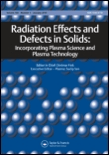
Radiation Effects and Defects in Solids
Exploring the Impact of Radiation on Solid MaterialsRadiation Effects and Defects in Solids is a prestigious academic journal published by TAYLOR & FRANCIS LTD that has been at the forefront of research related to the impacts of radiation on various solid materials since its inception in 1989. With an ISSN of 1042-0150 and an E-ISSN of 1029-4953, this journal serves as an essential resource for researchers and professionals in the fields of Condensed Matter Physics, Materials Science, and Nuclear and High Energy Physics. Despite its current categorization in the Q4 quartile across these disciplines, Radiation Effects and Defects in Solids remains critical for advancing knowledge of material responses to radiation, which is vital for applications in nuclear energy, space exploration, and radiation therapy. The journal publishes original research articles, reviews, and letters that provide insights into material properties, radiation dosimetry, and defect structures, fostering collaboration and innovation within the scientific community. As the field evolves, Radiation Effects and Defects in Solids continues to play a significant role in disseminating valuable research findings and keeping pace with emerging trends in materials science and radiation physics.
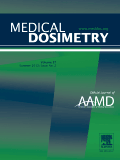
Medical Dosimetry
Bridging Theory and Practice in DosimetryMedical Dosimetry is a distinguished journal published by Elsevier Science Inc, dedicated to the advancing field of medical dosimetry and its applications within oncology, radiology, and nuclear medicine. With its ISSN 0958-3947 and E-ISSN 1873-4022, this journal serves as a crucial resource for researchers and professionals aiming to enhance their understanding of radiation treatment planning and dosage calculations. Encompassing a comprehensive range of topics from clinical dosimetry to technology assessment, Medical Dosimetry has been disseminating significant findings since its establishment in 1988, contributing to the continuous development of best practices in patient care and safety. The journal currently holds a Q3 ranking in various categories, reflecting its pivotal role in the research community, while not currently offering open access, it remains an essential reference for scholars advancing the techniques utilized in medical imaging and treatment. By fostering a platform for high-quality research, it aims to bridge the gap between theoretical studies and clinical applications, making it a vital addition to any medical library.